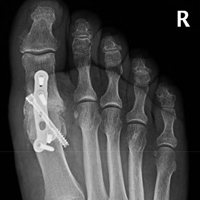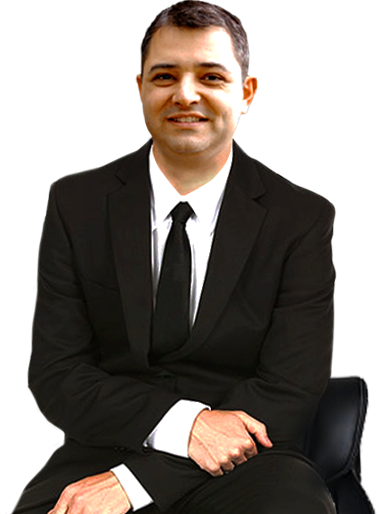Hallux Rigidus - Fusion Surgery Information
Pain and swelling at the base of the big toe is frequently caused by osteoarthritis of the 1st (big toe) metatarso-phalangeal joint. It results in pain, spurs and progressive restriction of movement. The cause is unfortunately unknown in most cases. The treatment is aimed at relieving pain. If non-operative means such as anti-inflammatories, accommodative footwear or orthoses fail to control symptoms surgery may be indicated.
The Surgery

For severe degeneration, arthrodesis is recommended. This surgery fuses the two bones at the base of the big toe. There will not be any movement at this joint after the surgery. You will have a general anaesthetic and local anaesthetic. An incision is made over the big-toe. The joint is stripped of degenerative cartilage and
temporarily aligned with smooth wires. The position is checked with simulated weight bearing. The two bones are then compressed with screws and a small thin plate to hold them in position. The position is checked with Xray before the wounds are sutured and a dressing is applied.
Post-Operatively
You can walk on the foot with a surgical shoe/sandal (provided) as soon as you are awake. You should walk on the heel and ball of the foot but not putting pressure on the big toe until the bones are healed. Crutches are optional. You will need to keep the foot elevated as often as possible, this is to control swelling and pain. You may need to take medication to control pain. You should keep the bandages dry and clean until your first post-operative clinic visit.
- Activity
- Timeframe (approximate)
- Walk with surgical shoe/sandal
- 6 wks
- Walking in wide shoes
- 6 wks– 3 mts
- Most activities and shoes
- 3 – 6 mts
- Full Recovery
- Up to 12 mts
- Type of Work
- Time off
- Sitting
- 2 weeks
- Standing
- 4 weeks
- Driving
- 6 weeks
- Lifting
- 8 weeks
Risks of surgery
All surgical procedures carry some risk. The risk of complications with big toe arthrodesis is low. Most patients benefit from this surgery. A small number of patients can be made worse. You should weigh up the benefits with the risks prior to electing to have surgery.
This is a list of the most common problems which can occur:
- Swelling – is normal and improves with time, but can occasionally persist past 6 months
- Wound healing problems – increased if smoking, diabetes, poor circulation
- Nerve injury – resulting in numbness or pins and needles, occasionally pain
- Bleeding – usually just visible through the dressing
- Infection – minimised with antibiotics, elevation, keeping the dressing clean and dry
- Pain – which may require strong medication (usually Paracetamol is adequate)
These are rarer complications, but they can and do happen:
- Non-union – this is when the bones fail to join, more common in smokers
- Malunion – this is when the toe position isn’t ideal, may require re-operation to correct
- Problems with fixation - loss of fixation, fracture, symptomatic hardware
- Failure to relieve pain or transfer of pain to other part of foot
- Complex regional pain syndrome (CRPS) – nerve pain syndrome, risk reduced with Vitamin C 500mg daily for 40 days
- DVT – clot in the deep veins of the leg (increased if smoking, contraceptive pill, hormone replacement or previous history)
- Anaesthetic complications – more likely if there are pre-existing medical disorders
You will need the Adobe Reader to view and print these documents.
![]()









